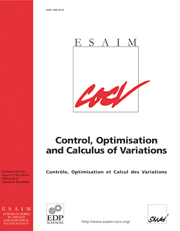Article contents
The steepest descent dynamical system with control. Applications to constrained minimization
Published online by Cambridge University Press: 15 March 2004
Abstract
Let H be a real Hilbert space, $\Phi_1: H\to \xR$  a convex function of class ${\mathcal C}^1$
a convex function of class ${\mathcal C}^1$  that we wish to minimize under the convexconstraint S.A classical approach consists in following the trajectories of the generalizedsteepest descent system (cf. Brézis [CITE]) appliedto the non-smooth function $\Phi_1+\delta_S$
that we wish to minimize under the convexconstraint S.A classical approach consists in following the trajectories of the generalizedsteepest descent system (cf. Brézis [CITE]) appliedto the non-smooth function $\Phi_1+\delta_S$  . Following Antipin [1], it is also possible to use a continuous gradient-projection system.We propose here an alternative method as follows:given a smooth convex function $\Phi_0: H\to \xR$
. Following Antipin [1], it is also possible to use a continuous gradient-projection system.We propose here an alternative method as follows:given a smooth convex function $\Phi_0: H\to \xR$  whose critical points coincidewith Sand a control parameter $\varepsilon:\xR_+\to \xR_+$
whose critical points coincidewith Sand a control parameter $\varepsilon:\xR_+\to \xR_+$  tending to zero,we consider the “Steepest Descent and Control” system \[(SDC) \qquad \dot{x}(t)+\nabla \Phi_0(x(t))+\varepsilon(t)\, \nabla \Phi_1(x(t))=0,\]
tending to zero,we consider the “Steepest Descent and Control” system \[(SDC) \qquad \dot{x}(t)+\nabla \Phi_0(x(t))+\varepsilon(t)\, \nabla \Phi_1(x(t))=0,\]  where the control ε satisfies $\int_0^{+\infty} \varepsilon(t)\, {\rm d}t =+\infty$
where the control ε satisfies $\int_0^{+\infty} \varepsilon(t)\, {\rm d}t =+\infty$  . This last condition ensures that ε “slowly” tends to 0. When H is finite dimensional, we then prove that $d(x(t), {\rm argmin}\kern 0.12em_S \Phi_1) \to 0\quad (t\to +\infty),$
. This last condition ensures that ε “slowly” tends to 0. When H is finite dimensional, we then prove that $d(x(t), {\rm argmin}\kern 0.12em_S \Phi_1) \to 0\quad (t\to +\infty),$  and we give sufficient conditions under which $x(t) \to \bar{x}\in \,{\rm argmin}\kern 0.12em_S \Phi_1$
and we give sufficient conditions under which $x(t) \to \bar{x}\in \,{\rm argmin}\kern 0.12em_S \Phi_1$  .We end the paper by numerical experiments allowing to compare the (SDC) system with the other systems already mentioned.
.We end the paper by numerical experiments allowing to compare the (SDC) system with the other systems already mentioned.
Keywords
- Type
- Research Article
- Information
- ESAIM: Control, Optimisation and Calculus of Variations , Volume 10 , Issue 2 , April 2004 , pp. 243 - 258
- Copyright
- © EDP Sciences, SMAI, 2004
References
- 16
- Cited by


